
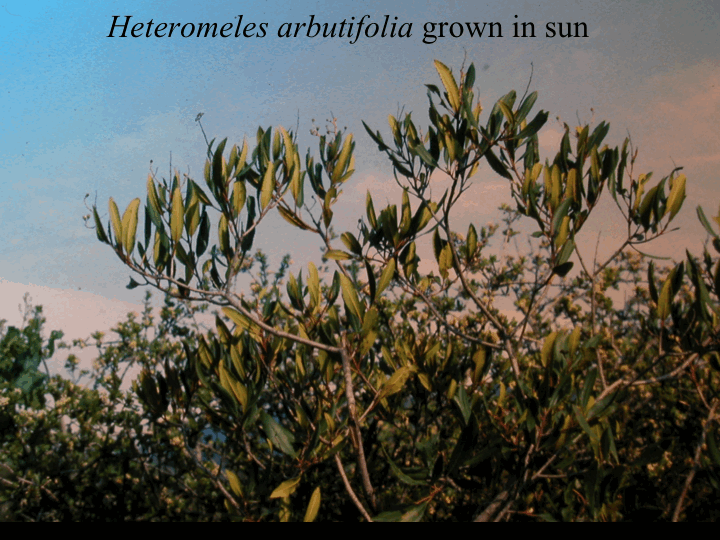
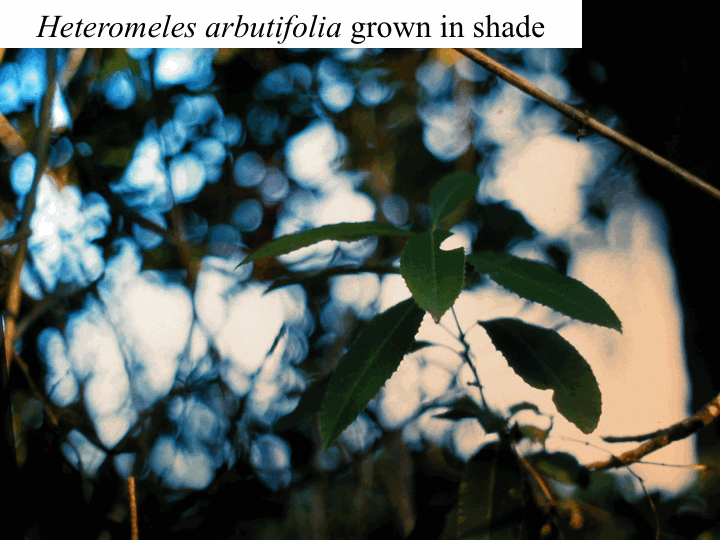
Plant Biology for the K-5 Classroom
Plant adaptations and habitats
[Note: Hyperlinks will open external links in new browser tabs or windows.]
Plants respond to the environment during normal growth and development, changing their shapes, characteristics, and direction of growth in ways that allow them to capture more sunlight, capture more water and mineral nutrients from the soil, etc. Common responses include phototropism in stems and petioles (growing or bending toward light), gravitropism in roots (growing toward gravity), negative gravitropism in stems (growing away from gravity), etiolation of young seedlings (growing tall and thin when in darkness), etc. These responses are important for plant survival and are common subjects of K-5 scientific investigations. The Plants-in-Motion website (http://plantsinmotion.bio.indiana.edu) contains numerous time-lapse videos of these responses, illustrating the types of investigations that can be carried out in a classroom, together with background information about these responses.
The information below, however, will focus on characteristics of plants and on plant responses that benefit plants only in certain environments. Specialized characteristics and responses that have evolved in response to certain conditions are called 'adaptations' to those conditions. Southern California has a large number of environments and habitats. The material below explains how various plant characteristics allow some species to thrive in certain areas and not in others.
The first section discusses characteristics that allow some plant species to deal with environmental challenges. The second section discusses the variation in climate and habitats found in (inland) Southern California.
(ponds, marshes, riparian areas [=along rivers])
Problem: Flooded soil can drown roots. Roots, like animals, require oxygen to break down sugars to supply them with energy. Only the green parts of a plant produce sugar and oxygen. Roots of most plants get their oxygen from the air spaces between soil particles.
Solution: Most wetland plants have air channels inside their bodies, extending from aboveground parts of the plant down into the roots. They use these air channels to get oxygen to their roots.
Problems:
Solutions to having little water (having dry soil):
Grow deep roots. Usually, the surface soil dries out first and deeper soil may remain moist throughout the year. Some plants have such deep roots, they can reach a water table (the depth at which you hit water if you dig a well). These types of plants are called "phreatophytes".
Produce succulent leaves or stems. Some species, like cacti, produce succulent stems with large cells that can swell to take in and store water when it rains, then shrink as the plant loses water slowly through the dry periods. Interestingly, cacti are often not deeply rooted. Instead, they produce roots near the soil surface to absorb water from even small rainfall events that only wet the surface soil.
Drop the largest leaves during the drought. This reduces the amount of water that will be lost from leaves during the drought, protecting the root and stem from drying out. Plants that drop leaves during dry periods are called "drought-deciduous" plants. (In contrast, the more common pattern of seasonal leaf drop is for a plant to drop its leaves during the winter; those plants are called "winter-deciduous" plants.)
Have an annual life cycle. Some plant species exist in the environment only as seed during the drought. Most seeds are desiccation tolerant. That is, they can lose all their water without dying. These species avoid the drought by growing actively only during the times of the year when water is available.
Reduce water loss from the leaves by reducing leaf temperature. A plant can reduce its temperature by reducing the amount of sunlight it absorbs. This can be achieved by having light-colored leaves and/or having vertically oriented leaves. Light, reflective leaves absorb less sunlight than dark leaves. Vertically oriented leaves intercept less sunlight at mid-day than horizontal leaves.



Additionally, the soil surface may get quite hot during the summer. In such environments, plants may lose their lower leaves and produce higher leaves, further away from this hot surface, as the summer heat and drought develops.
Reduce water loss from leaves by slowing the wind that blows over the stomata. This is usually achieved by growing leaf hairs on the side of the leaf that has stomata.
The factors that affect leaf temperature and water loss from leaves can be explained in fairly simple terms and investigated in ways that link plant adaptations and physical science standards at the K-5 level.
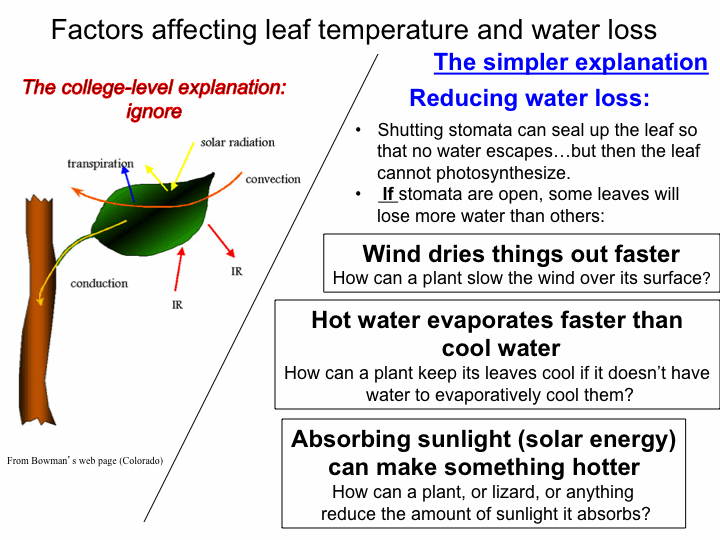
Note the dense white hairs and the cupped shape of the leaves on the California buckwheat, below. These provide a pocket of still air over the stomata that remains a little more humid than the outside air, slowing evaporation.

Convective heat exchange is a process by which heat moves to or from a surface on moving molecules.
The direction of heat movement is from hotter to cooler. If a surface is hotter than air temperature, it will lose heat to the air through convective heat exchange. If the surface is cooler than air temperature it will gain heat from the air through convective heat exchange. If the rate of convective heat exchange is very high, the surface temperature will to stay near air temperature by rapid loss of heat to the air or rapid gain of heat from the air.
Anything that slows air movement near a surface will slow convective heat exchange. (The number of air molecules hitting the surface per unit time decreases.) Slowing air near the leaf...
Air near a leaf can be slowed by:
Note: The effect of leaf width on the depth of the boundary layer. The boundary layer is always thinnest at the windward edge of a surface. As the air moves over the surface, increasing numbers of molecules interact with the surface and interfere with each other, increasing the depth of the boundary layer. The image below shows a graphic representation of a boundary layer, with air (indicated by arrows) moving from left to right across a leaf. The depth of relatively still air builds up as air moves across a wide surface. A narrow leaf is amost all "edge", and the air is past the leaf before a thick boundary layer is produced.

Check your understanding:
For the next few questions, refer to the spring leaves ("early season leaves") and summer leaves ("late season leaves") of Diplacus aurantiacus, shown below.
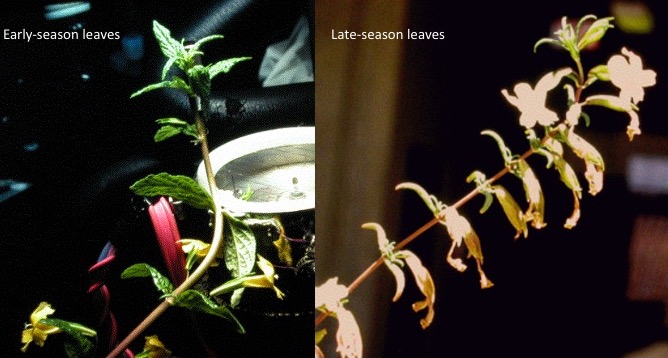
Encelia farinosa (below) produces darker leaves early in the spring, and more hairy, silver leaves later in the season. These hairs are very short but quite light colored.
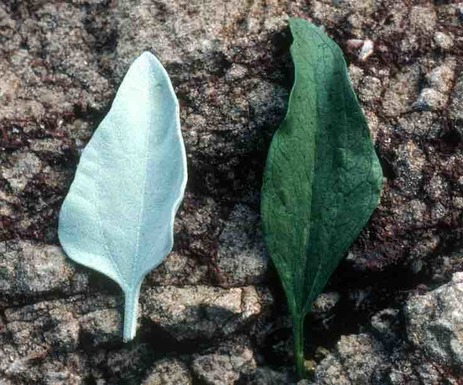
Problems:
Solutions:
Be short. During the winter, plants often sustain less damage if they are covered by snow than if they stick up above the snow surface and are exposed to blowing ice crystals. In the spring, when the snow first melts, daytime air temperatures are warmer near the ground than they are farther from the ground surface. (The ground absorbs sunlight and heats up, warming the air right above it.) Plants that put their leaves in this warm micro-environment can grow faster.
Be winter-deciduous. Dropping leaves during the winter and protecting growing tips with hard little scale leaves prevents damage to the leaves and buds. [Note: there is a difference between dropping a leaf in an organized manner and losing a leaf to some type of damage. Before a plant drops a leaf, it breaks down a lot of the protein in the leaf and ships it, together with many of the mineral nutrients in the leaf, back into the rest of the plant for later use. This cannot be done if a leaf is lost to ice damage, herbivory, hedge trimmers, fire, etc.]
For an evergreen plant: produce tough leaves that last for years. Evergreen plants keep leaves on the plant all year. Pine trees are evergreen. Their leaves (needles) are tough, so they resist damage and may live a long time.
Have dormant seeds that require exposure to damp, cold conditions before seeds will germinate. This prevents seeds from germinating during any late-summer or autumn rains, which would produce young seedlings that would be trying to grow during the winter. It cues them to germinate at the beginning of spring, when conditions are better for seedling survival. [In horticultural practice, exposing seeds to a period of cold, damp conditions is called "cold stratification".]
Problem: Fire can kill plants, at least the aboveground parts of a plant. [Note: Dry soil, with its small pockets of still air, provides good insulation, and belowground plant parts may live through a fire.]
Solutions:
Resprout from belowground organs like a root crown (where the root meets the stem) or a rhizome (an underground, horizontal stem). Not all plants can do this. They have to have buds below ground that can start growing to produce a new stem, and they have to have sufficient storage reserves (starch) below ground to provide energy to produce the new stems and to keep the root alive while the stem is growing.
Have a life cycle that typically involves dying down to the ground each year and producing a new shoot from belowground roots, bulbs, corms, etc. These types of plants are typically dormant during late summer, when most fires occur anyway, with only the belowground parts alive. These belowground parts are protected from heat by the insulating properties of dry soil.
Have an annual life cycle. Again, these plants are often dead by the time most fires occur in southern California, and seeds in the soil germinate, as usual, with the next rains.
For a tree: have thick, insulating bark that protects the vascular cambium (the cell layer right under the bark that produces new xylem and phloem). If the tree is tall enough that its crown (the live branches and leaves) does not burn up in the fire, protecting the cambium will insure that the tree can continue to produce new xylem, to get water to the leaves, and new phloem, to get sugars to the roots, after the fire.
Have seeds that are stimulated to germinate by either heat or chemicals in smoke. This causes seeds to germinate in the 1-2 years after a fire, when competition from other plants is low and conditions are good for seedling survival. Species that have seeds with these types of germination requirements often build up soil seed banks over years, producing seeds every year that do not germinate, but are added to the soil seed bank (a collection of dormant seeds in the soil). After a fire, fire-stimulated germination will deplete the soil seed bank (because the seeds germinated), and germination after subsequent fires will depend on whether the species has managed to replenish the soil seed bank since the last fire.
Have cones that open to release seeds after fire. Conifers (pines and relatives) that do this typically hold cones on their branches for years. Seeds are released when fires come through. Not all conifers do this.
Resource: The USDA Forest Service maintains a database of information on fire responses of different species. It does not contain information on all species, but if you are interested in the fire response of a particular species, the Forest Service's Fire Effects Information System (http://www.fs.fed.us/database/feis/plants/) is a good place to start.
Problem: Getting eaten can kill a plant; getting partially eaten damages it and can slow its growth. [Only fleshy fruits have characteristics that encourage animals to eat plant material: in this case, the plant benefits by having its seeds dispersed.]
Solutions:
Have characteristics that allow the plant to recover from herbivory (replace lost tissue). Plants have to have buds that are not eaten (at ground level, below ground level, or in some other protected position) and have the starch reserves to produce new tissue.
Have characteristics that discourage herbivory. Plants may be physically defended with spines, thorns, stinging hairs, etc. Plants may also be toxic or bad-tasting. [Do not eat any plant tissue you do not know is edible. We get food from plants, but we also get medicines from plants...and almost all medicines are toxic if you take too much. The castor bean seed contains ricin, one of the most toxic compounds known to man.]
Problem: Plants compete with each other for light, water and other resources. The tallest plant gets light and blocks light to shorter plants. In environments with seasonal droughts, fast-growing plants may use up surface water early, depriving later-growing or slower growing plants of water. Competition is so pervasive, we will not discuss specific characteristics that give a plant a competitive advantage over others.
However, you should know that seedlings and adult plants of a species see different environments. Babies start out small. Thus, the seedling of a large shrub or tree species starts its life seeing only the environment in the top few inches above and below the soil. At this stage, even short, fast-growing annuals like weedy grasses may outcompete a tree seedling, and no new trees or shrubs will grow where their seedlings don't survive.
Check your understanding:
Due to its wide range of elevations, rock types, and interactions with the ocean, southern California has a range of climates and habitat types.
Elevation affects temperature: the higher you go on a mountain, the cooler it is. And mountains affect rainfall: as air from the ocean moves across the land and is pushed up a mountain into cooler zones, water vapor in the air condeses and it rains. This leaves the air with less moisture in it as the air moves down the side of the mountain away from the ocean. Thus, the ocean-facing sides of mountains are usually wetter (not wet, but wetter) than the sides away from the ocean. Southern California has three different climate types:
The map below shows the potential distribution of major vegetation types in the Los Angeles/Inland Empire/Victorville area. The red dot shows the location of California State University, San Bernardino. The higher elevations of the San Gabriel Mountains and the San Bernardino Mountains are covered in forest types, like jeffrey pine forest. On the desert-facing slopes of these mountains, juniper and pinyon pines occur, with various types of desert scrub occuring at lower elevations. On the coastal side of the mountains, chaparral is found below the forests, and coastal sage scrub is found at lower elevations. Very little coastal sage scrub remains today, because most of its former range has been covered by urban development.
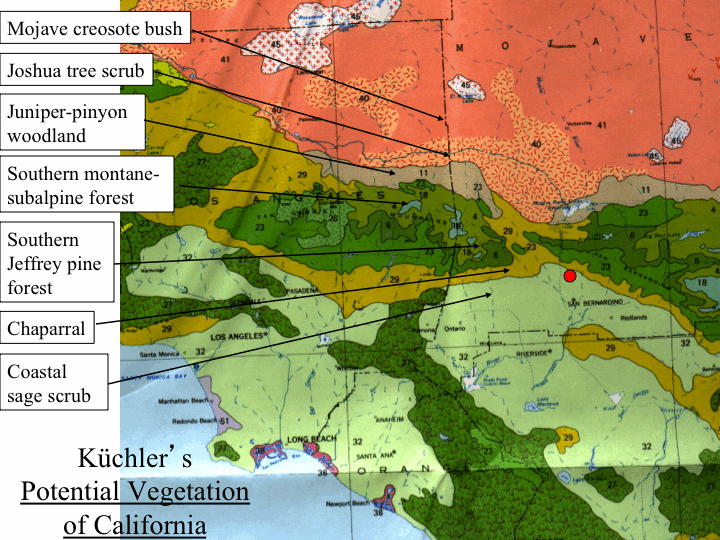
A brief description of these different vegetation types, with special emphasis on their response to fire, is given below.
 Jeffrey pines and ponderosa pines are very similar in appearance, Both occur in the the San Gabriel and San Bernardino Mountains. These trees have thick bark that protect them from the heat of low-intensity ground fires when the trees are mature. Historically, frequent fires kept the understory low and open. (The understory consists of the shorter plants below the canopies of the mature trees.) Thick bark protected the mature trees from the resulting low ground fires. Studies of fire scars on trees in the San Bernardino Mountains indicated that these forest stands burned, on average, every 10-12 years before 1905, when the Forest Service and organized fire-suppression efforts began. These same fire scar records indicated that fires became less frequent after 1905, occuring on average, every 22-29 years (McBride and Lavin, 1976), This type of pattern has been observed throughout the western United States. The reduced fire frequency has allowed shrubs and small trees in the understory to grow more thickly, creating a situation in which fires do not remain small and low, but burn up into the tree canopies using the thick shrubs and small trees as "ladder fuels". Mechanical treatments and deliberate, prescribed burns to return these forests to a more open state and keep fires low are now part of forest management in jeffrey pine and ponderosa pine forests.
Jeffrey pines and ponderosa pines are very similar in appearance, Both occur in the the San Gabriel and San Bernardino Mountains. These trees have thick bark that protect them from the heat of low-intensity ground fires when the trees are mature. Historically, frequent fires kept the understory low and open. (The understory consists of the shorter plants below the canopies of the mature trees.) Thick bark protected the mature trees from the resulting low ground fires. Studies of fire scars on trees in the San Bernardino Mountains indicated that these forest stands burned, on average, every 10-12 years before 1905, when the Forest Service and organized fire-suppression efforts began. These same fire scar records indicated that fires became less frequent after 1905, occuring on average, every 22-29 years (McBride and Lavin, 1976), This type of pattern has been observed throughout the western United States. The reduced fire frequency has allowed shrubs and small trees in the understory to grow more thickly, creating a situation in which fires do not remain small and low, but burn up into the tree canopies using the thick shrubs and small trees as "ladder fuels". Mechanical treatments and deliberate, prescribed burns to return these forests to a more open state and keep fires low are now part of forest management in jeffrey pine and ponderosa pine forests.
 Pinyon pine woodlands occur on the desert-
Pinyon pine woodlands occur on the desert-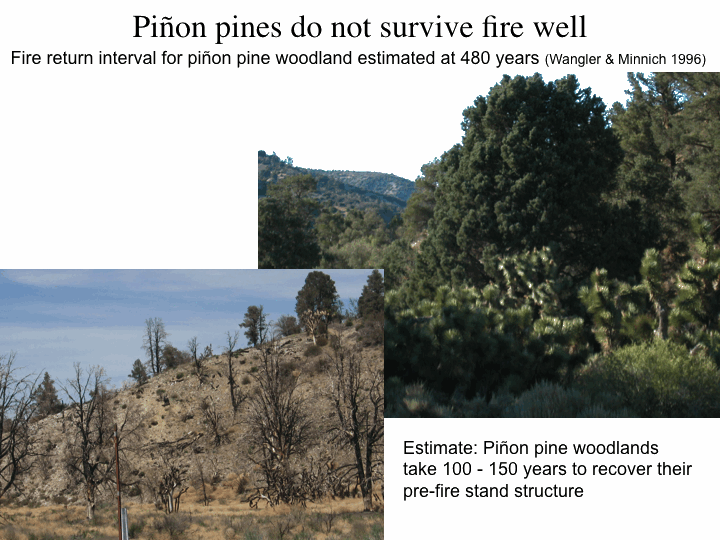 facing slopes of the mountains in southern California. Pinyon pines produce large seeds that are often harvested, shelled, and eaten by humans as "pIne nuts". In contrast to jeffrey pines and ponderosa pines, pinyon pines do not tolerate fire well. Mature pinyon pine trees do not have bark that is thick enough to protect them, and even low-intensity ground fires will kill the trees. Researchers from UC Riverside have estimated that, historically, pinyon pine forests in southern California burned, on average, only once every 480 years. They also estimated that it took 100-150 years for a burned pinyon pine woodland to recover enough to look the way it did before a fire (Wangler and Minnich, 1996). As a result, using prescribed fire is probably not a good way to manage pinyon pine forests if the objective is to keep the pinyon pine forest healthy.
facing slopes of the mountains in southern California. Pinyon pines produce large seeds that are often harvested, shelled, and eaten by humans as "pIne nuts". In contrast to jeffrey pines and ponderosa pines, pinyon pines do not tolerate fire well. Mature pinyon pine trees do not have bark that is thick enough to protect them, and even low-intensity ground fires will kill the trees. Researchers from UC Riverside have estimated that, historically, pinyon pine forests in southern California burned, on average, only once every 480 years. They also estimated that it took 100-150 years for a burned pinyon pine woodland to recover enough to look the way it did before a fire (Wangler and Minnich, 1996). As a result, using prescribed fire is probably not a good way to manage pinyon pine forests if the objective is to keep the pinyon pine forest healthy.
The desert shown on the map above is the Mojave Desert, dominated by creosote bush and Joshua trees. The Mojave Desert receives less summer rain than the Sonoran Desert which lies to the southeast of the Mojave Desert and contains the large columar cacti that most people think of when they think of deserts. In the Mojave Desert, low shrubs and cacti occur may occur among the creosote bushes and Joshua trees. In wet years, ephemeral annual wildflowers may carpet the open spaces between shrubs. These ephemerals (meaning "lasting a short time") germinate, grow quickly, flower, and produce seed during the short periods that water is available near the surface of the soil.
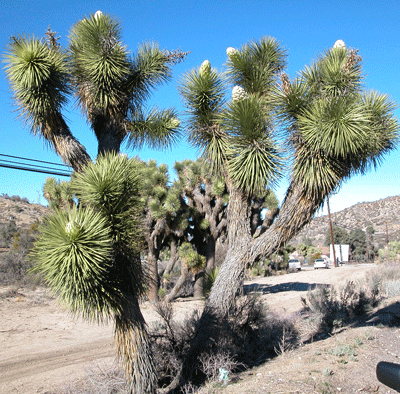 The dominants of the Mojave Desert are long-lived and have
The dominants of the Mojave Desert are long-lived and have 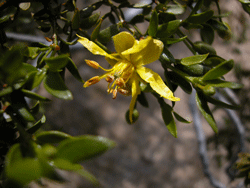 interesting pollination characteristics. Joshua trees (left) are generally restricted to the Mojave Desert and can live to be several hundred years old. They are pollinated by only two types of yucca moths that lay their eggs in the ovary of a flower, then deposit a ball of pollen on the stigma of the pistil. Pollination ensures that seeds develop in the ovary, and seed development ensures that the moth larvae have something to each when they hatch. (This only benefits the plant if the larvae do not eat all the seeds.) Creosote bush (right), which is more widely distributed than the Joshua tree, may fragment and produce clones of bushes as the plants age. The oldest clone known exists in Lucerne Valley, California, and is estimated to be over 11,000 years old. The yellow petals of the flowers of creosote bush are reported to twist 90 degrees after the flower has been pollinated. Information on these two species may be found in many sources on the web, including the US Forest Service's Fire Ecology Information System (http://www.fs.fed.us/database/feis/plants/) and the University of Arizona Arboretum website (http://apps.cals.arizona.edu/arboretum/taxon.aspx?id=36).
interesting pollination characteristics. Joshua trees (left) are generally restricted to the Mojave Desert and can live to be several hundred years old. They are pollinated by only two types of yucca moths that lay their eggs in the ovary of a flower, then deposit a ball of pollen on the stigma of the pistil. Pollination ensures that seeds develop in the ovary, and seed development ensures that the moth larvae have something to each when they hatch. (This only benefits the plant if the larvae do not eat all the seeds.) Creosote bush (right), which is more widely distributed than the Joshua tree, may fragment and produce clones of bushes as the plants age. The oldest clone known exists in Lucerne Valley, California, and is estimated to be over 11,000 years old. The yellow petals of the flowers of creosote bush are reported to twist 90 degrees after the flower has been pollinated. Information on these two species may be found in many sources on the web, including the US Forest Service's Fire Ecology Information System (http://www.fs.fed.us/database/feis/plants/) and the University of Arizona Arboretum website (http://apps.cals.arizona.edu/arboretum/taxon.aspx?id=36).
In undisturbed desert, there are often large spaces between shrubs. This does not mean the shrubs are not competing with each other. For many desert shrubs, most of the the plant's body is below ground. There can be strong competiton between the roots of desert plants for water and other soil resources, even if it looks like the shrubs are widely spaced. We see only a small part of the plant: the aboveground part.
Like the pinyon pines, few desert plants can tolerate fire. In the past, large openings between desert shrubs kept fires from spreading and burning large areas. Today, non-native annuals like red brome grass (from Europe) have colonized large areas of the desert, creating continuous carpets of fine fuels that carry fire and have resulted in more frequent fire. In recent years, non-native annuals in the mustard family have followed the non-native grasses into the desert, spreading along roads and colonizing disturbed areas. These invasive, non-native plants are considered to be among the worst threats to the native desert vegetation because they both compete with the native desert plants and promote fire.
|
Intact desert vegetation near Phelan, CA |
Disturbed desert site, colonized by tumble mustard (Sisymbrium altissimum, from Europe) |
 Chaparral vegetation is dominated by evergreen, sclerophyllous ("hard-leaved") shrubs. The image to the left shows a disturbed opening in mature chaparral, which covers the hillsides in the background.
Chaparral vegetation is dominated by evergreen, sclerophyllous ("hard-leaved") shrubs. The image to the left shows a disturbed opening in mature chaparral, which covers the hillsides in the background.
Different plant species have different ways of recoving from fire. Some shrub species resprout from root crowns or rhizomes after fire. Some are killed by fire and have seeds in a seedbank that are stimulated to germinate following fire. Geophytes (plants with underground storage organs that die back to the ground each summer), simply regrow from their underground storage organs. Annual plants are rare in mature chaparral, being found only in openings. However, many have seeds that are stimulated to germinate by heat or smoke, and wildflowers may carpet the area the spring after a fire. Seeds of these fire-followers may remain dormant in the soil for 50 years or more, existing only in the seedbank between fires, and germinating to produced flowering plants after a fire.
Although chaparral vegetation is adapted to fire, fires that are too frequent can eliminate chaparral species. If a resprouting species is reburned 1-2 years after a fire, it may be unable to resprout again: it depletes its starch reserves in the root by producing new shoots after the first fire, then does not have time to build up enough starch reserves between fires to successfully resprout again. If an "obligate seeder" is burned, it will be eliminated from a site if a second fire occurs before the plants germinate, grow, mature and set seed. An obligate seeder is a species that dies in a fire and has seeds in a soil seed bank that are stimulated to germinate by smoke or heat. A fire will kill existing plants and stimulate germination. The germination will deplete the soil seed bank. No new seeds will be added to the soil seed bank until the seedlings grow into mature plants that flower and produce seeds. The species that are most vulnerable to a short fire-return interval (time between fires) are the obligate seeders that grow slowly and take many years to reach maturity and produce many seeds.
Most chaparral species can persist in areas where fire occurs once every 20-80 years. Some species can tolerate more frequent fires, but not all species.
|
Wild cucumber has a large storage root. It dies back to the ground each summer and a new shoot emerges with the first rains. It is usually not damaged at all by fires. |
Toyon and many other species will resprout from root crowns |
Hoary-leaved ceanothus is an obligate seeder. It dies in a fire. It takes 8-10 years to reach maturity and longer to get big enough to produce enough seed to replenish the soil seed bank. |
Annual fire-followers, stimulated to germinate by fire, may bloom profusely in the 1-2 years after a fire. |
Coastal sage scrub, like chaparral, is dominated by shrubs. The dominant shrubs of coastal sage scrub, though, are more shallowly rooted than those of chaparral, and most are drought-deciduous. (These traits are related: shallowly rooted shrubs do not have access to deep soil water, so they can't supply water to their leaves all summer. Therefore, they just drop most of them.) Leaves of these shrubs are flexible, not hard and durable like the leaves of the chaparral dominants. For this reason, coastal sage scrub is sometimes called "soft chaparral".
Dominant shrubs of coastal sage scrub include members of the mint family (black sage, white sage, purple sage, etc.) and California sagebrush. They tend to be shorter than shrubs of hard chaparral and mature more quickly, most maturing within four years. Therefore, although most of these shrubs are killed by fire, they can complete their life cycle in just a few years, and withstand more frequent fires than many species of hard chaparral. Fires that occur more frequently than once every four years, however, will tend to eliminate these shrubs, converting the site to an annual grassland.s
|
March 2002 (Before the fire) |
December 2003 (photo: David Neighbours) |
March 2004 (5 months after fire)
|
May 2005 (Second spring after fire) |
April 2006 (Third spring after fire) |
Annual grasslands in California are dominated by non-native annual grasses that have been introduced into California since Europeans arrived. Most of these introductions were probably accidental. There is some debate about what grasslands of California actually looked like before these introduced grasses took over. Some people think they were dominated by native perennial grasses; others think they were dominated by native wildflowers, like the California poppy.
 Today, annual grasses tend to replace native plant communities where frequent fire, mechanical disturbance, or other disturbances eliminate the native vegetation. These grasses grow early in the spring and use up water in the upper soil layers. This makes it difficult for seedlings of other species (including shrub, tree, and wildflower seedlings) to survive. The grasses outcompete them for water. Furthermore, these grasses die relatively early in the season, providing fine fuels that ignite easily and promote frequent fires. As noted above, frequent fires will eliminate many native species, leaving the grasses to dominate the site.
Today, annual grasses tend to replace native plant communities where frequent fire, mechanical disturbance, or other disturbances eliminate the native vegetation. These grasses grow early in the spring and use up water in the upper soil layers. This makes it difficult for seedlings of other species (including shrub, tree, and wildflower seedlings) to survive. The grasses outcompete them for water. Furthermore, these grasses die relatively early in the season, providing fine fuels that ignite easily and promote frequent fires. As noted above, frequent fires will eliminate many native species, leaving the grasses to dominate the site.
Check your understanding:
McBride, J. R., & Laven, R. D. (1976). Scars as an indicator of fire frequency in the San Bernardino Mountains, California. Journal of Forestry, 74(7), 439-442.
Wangler, M. J. & Minnich, R. A. (1996). Fires and succesion in pinyon-juniper woodlands of the San Bernardino Mountains, California. Madroño, 43(4), 493-514.